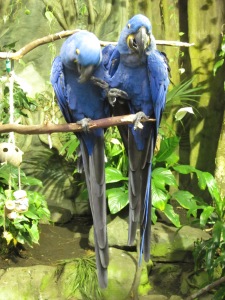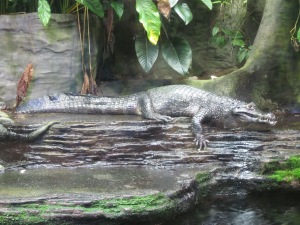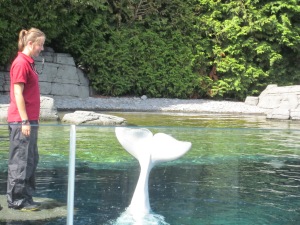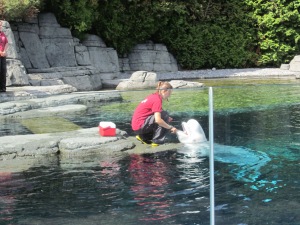While my friend Jennie was here we went to the Vancouver Aquarium (click here for their official page). It is nestled in amongst the large area that is Stanley Park, so a natural extension of our Stanley Park outing was to head to the aquarium – and both of us being die hard marine scientists (well, originally I was a marine scientist at least), it’s actually pretty interesting too.
The aquarium had the usual array of tanks of jellyfish all back lit so they looked really amazing, and different types of fish, sharks, rays etc swimming around. There were also parrots, turtles (or tortoises?) frogs, an alligator, and of course, seals, dolphins and excitingly, beluga whales.
Now my conundrum came about when I heard there were whales at the aquarium – whales?! Seriously? Don’t get me wrong, I am a sucker tourist like all the rest, and I went to one of the whale (and penguin) shows they hold. I had never seen a beluga whale (who has?), merely the flukes of a diving right whale off the coast of Kaikoura in New Zealand. I learnt a lot about these beautiful creatures, and had they not been in an aquarium I doubt I would ever see one in my whole life, given they live in the Arctic and sub-Arctic waters. Many interesting facts are posted on the Vancouver Aquarium’s website (click here for the fact page on belugas).
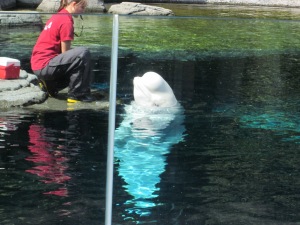
Beluga Whale, with it’s prominent forehead, that wobbles side to side when they shake their heads, like a bowl of jelly.
But such a beautiful, wild creature in captivity? That seemed a bit cruel. I am a fence-sitter when it comes to eco-tourism such as this. On the one hand, having these creatures in captivity, well-trained, putting on shows, helps the general public to understand more about animals in the wild and conservation, and how human actions can have such large detrimental impacts on these species. Educating the public about these issues is the grass-roots of conservation, changing public attitudes and behaviours, which eventually can lead to enough pressure on a political level to bring about change (shame two countries are blocking the establishment of a marine protected area in Antarctica’s Ross Sea however – click here). Also, I don’t know if these animals were born in the aquarium, but if so their chances of surviving out in the wild are pretty minimal. On the other hand, they weren’t born to live in a glass cage. However, I think the aquarium does a fantastic job. The whales seemed very responsive to their trainers, well-stimulated, healthy looking animals. But their enclosure was not that large (I guess however I’m thinking of the open ocean where they come from, but still).
By contrast, I thought the dolphins were going out of their minds. One dolphin swam around the same circuit, around and around and around, upside down for part of his (her?) circuit in the same place every time, around and around and around. A clear sign of under-stimulation in an animal (I learned this in regards to laboratory animals kept in cages for experiments, but I’m sure it extends to any animal kept in a cage for an extended period). Put simply, they don’t have enough to do, enough to keep them occupied, and as a result they display repetitious behaviour. Think of a hamster running on its wheel, around and around and around, never ending. That is usually a sign there are not enough things, e.g., toys, chew sticks, places to dig or burrow, in the cage to keep them occupied. And from what I saw of this dolphin, I got the same impression. Imagine yourself, locked in a 2 room apartment forever, no tv, radio, computer, books, paper, pens – nothing to stimulate your brain or body. You would probably, eventually, start pacing in circles just for something to do.
Is there really a place for captive animals like this? Zoos that run breeding programmes for endangered species clearly are keeping animals for a conservation point, keeping species alive that have usually declined thanks to human activity. Is education of the public a big enough reason for keeping what should be wild animals, in a glass looking cage? Do we need these specimens on display to further our knowledge and understanding, to build public support to pressure governments into protecting habitat for these species? Or are we merely voyeurs who like a good show? Much as I hate to see animals caged up, I personally think building public awareness and education is paramount to saving these species.
So, Go Vancouver Aquarium! Despite feeling torn by seeing whales and dolphins in captivity, I think you are doing a great job by raising public awareness.
